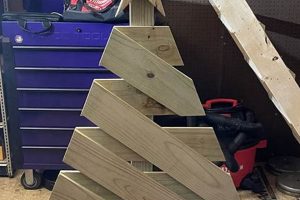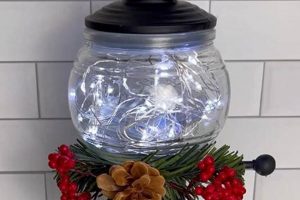A constructed holiday decoration fashioned from reclaimed wooden shipping platforms, offers an alternative to the traditional conifer. These structures often mimic the shape of the evergreen associated with the season and are intended for indoor or outdoor display during the holiday period. As an example, individuals may disassemble a standard pallet, cut the planks into progressively shorter lengths, and then affix them to a central support to create a tiered, tree-like silhouette.
The appeal of this type of festive decor lies in its sustainable nature, cost-effectiveness, and customizable design. Repurposing materials reduces waste, while the readily available and often free source material minimizes expenses. Historically, the practice of creating alternative Christmas trees has emerged from various motivations, including resourcefulness, environmental consciousness, and the desire for unique personal expression during the holiday season.
The following sections will detail the processes involved in creating this unique decoration, exploring design considerations, construction techniques, and finishing options.
Essential Guidance for Pallet-Based Holiday Tree Construction
The subsequent guidelines provide crucial information to ensure successful and safe construction of a festive decoration utilizing repurposed wooden platforms.
Tip 1: Material Selection: Prioritize heat-treated (HT) pallets over those treated with methyl bromide (MB), a hazardous fumigant. Markings indicating treatment should be clearly visible on the pallet. Avoid pallets with signs of chemical spills or excessive damage.
Tip 2: Disassembly Technique: Employ appropriate safety equipment, including eye protection and work gloves, during the disassembly process. A reciprocating saw or pry bar can be used to separate the planks. Exercise caution to avoid splintering and nail-related injuries.
Tip 3: Design Planning: Prior to cutting, create a detailed plan outlining the desired dimensions and overall aesthetic. This will minimize material waste and ensure a cohesive final product. Consider the available space for the finished creation.
Tip 4: Safe Cutting Practices: Utilize a stable work surface and secure the lumber during cutting operations. Ensure the saw blade is appropriate for the material being cut. Wear appropriate safety gear to prevent injury.
Tip 5: Secure Assembly: Employ screws or nails designed for wood construction to ensure a sturdy structure. Predrilling pilot holes can prevent splitting, particularly when working with dry or brittle lumber.
Tip 6: Stable Base Construction: Design and implement a robust base to support the assembled structure. A wide base is essential to prevent toppling, especially when the decoration is placed outdoors or in high-traffic areas.
Tip 7: Finishing Considerations: If painting or staining, select products formulated for exterior use to enhance durability and weather resistance. Allow sufficient drying time before adding decorative elements.
Adherence to these recommendations will contribute to the construction of a durable, visually appealing, and safe holiday decoration.
The article will proceed to explore various decorative options and placement strategies for the completed creation.
1. Pallet Selection
Pallet selection directly influences the structural integrity, aesthetic quality, and overall safety of the finished decoration. The type and condition of the pallet determine the available material’s strength, texture, and potential for splintering or cracking. For instance, using pallets constructed from hardwoods offers increased durability compared to those made from softwoods. The presence of excessive weathering or decay in the initial pallet material compromises the finished product’s longevity. The selection process is therefore a critical precursor to any subsequent construction steps.
Moreover, the treatment history of the pallet impacts safety. Pallets treated with methyl bromide, while less common now, pose significant health risks and are unsuitable for reuse in crafting projects. Heat-treated pallets, identified by the “HT” stamp, represent a safer alternative. An example illustrating the significance of selection involves choosing pallets free from chemical stains or spills, which could leach into the finished decoration and pose a hazard. The dimensions and uniformity of the pallet planks also affect the design possibilities; consistent plank sizes simplify the cutting and assembly process.
In conclusion, careful pallet selection is paramount to the success of the construction endeavor. It impacts structural soundness, safety, and the final appearance. Overlooking this initial step can lead to a compromised final creation, characterized by reduced durability, aesthetic flaws, or potential safety hazards. Consideration of material type, treatment history, and overall condition is thus essential.
2. Disassembly Safety
The creation of holiday decorations from repurposed shipping platforms necessitates careful attention to disassembly safety. The structural components are often held together with nails, staples, or screws, posing significant risks of injury during the separation process. Neglecting appropriate safety measures during disassembly may result in lacerations, punctures, or musculoskeletal strain. A common scenario involves attempting to pry planks apart without proper leverage or protective equipment, leading to sudden slippage and subsequent hand injuries. The use of damaged or worn tools further increases the likelihood of accidents. Adherence to established safety protocols is therefore a critical prerequisite for engaging in this type of project.
The specific hazards encountered during the disassembly phase also relate to the condition of the wood itself. Pallets exposed to outdoor elements may harbor mold, insects, or splinters, all of which present potential health risks. Direct skin contact with contaminated wood can trigger allergic reactions or infections. Furthermore, inhaling dust generated during the cutting or prying process may irritate the respiratory system. To mitigate these risks, appropriate personal protective equipment (PPE), including gloves, eye protection, and a dust mask, should be consistently worn. The work area should be well-ventilated, and tools should be inspected for proper functionality before each use. For instance, dull saw blades require greater force, increasing the chance of kickback and potential injury. Additionally, implementing a controlled dismantling process, such as using a dedicated pallet breaker tool, minimizes the likelihood of sudden and uncontrolled movements.
In summary, the safe disassembly of shipping platforms for the construction of holiday decorations demands a proactive approach to risk mitigation. The potential consequences of neglecting safety precautions range from minor injuries to more severe health complications. Implementing proper PPE, maintaining a safe work environment, and employing appropriate tools and techniques are essential for minimizing these risks. This diligent approach not only protects the individual undertaking the project but also contributes to the overall sustainability of the repurposing endeavor.
3. Design Blueprint
A comprehensive design blueprint is foundational to the successful creation of a holiday decoration constructed from repurposed wooden shipping platforms. This blueprint serves as a visual and technical guide, dictating the final dimensions, shape, and aesthetic characteristics of the structure. Without a well-defined plan, the resulting creation may lack structural integrity, visual cohesion, or both, thereby undermining the overall objective.
- Dimensional Specifications
Dimensional specifications outline the precise height, width, and depth of the holiday decoration, as well as the individual dimensions of each wooden component. A detailed specification ensures that all elements fit together as intended, preventing issues such as instability or aesthetic asymmetry. For example, a blueprint might specify that the base of the decoration be a certain width to provide adequate support for the upper sections. Deviation from these measurements can lead to an unbalanced or structurally unsound final product.
- Material Allocation and Cutting Plan
The design blueprint incorporates a material allocation plan that dictates how many planks from the reclaimed wooden platforms are required for each section of the decoration. It outlines a precise cutting plan, indicating the specific lengths and angles to which each plank must be cut. This is crucial for minimizing material waste and ensuring a uniform appearance. A typical example includes mapping how many planks need to be cut at progressively shorter lengths to achieve a tapered, tree-like silhouette. Failure to adhere to this plan may result in insufficient materials or inconsistent plank sizes, hindering the assembly process.
- Assembly Methodology
The blueprint details the specific assembly methodology, outlining the sequence in which the wooden components are to be joined, as well as the types of fasteners (screws, nails, etc.) to be used. This section also specifies the location of each fastener to ensure maximum structural strength. For instance, the blueprint might indicate that each plank should be attached to the central support with two screws, spaced evenly apart. A poorly defined assembly methodology can lead to weak joints, compromising the stability of the finished decoration, particularly when placed outdoors or in high-traffic areas.
- Aesthetic Considerations and Finishing Details
Beyond structural elements, the design blueprint addresses aesthetic considerations, specifying the desired finish (paint, stain, natural), as well as any decorative elements to be added, such as lights, ornaments, or ribbons. This section ensures a cohesive and visually appealing final product. The blueprint may specify a particular color scheme or a pattern for arranging the decorative elements. For example, it might indicate that the decoration be painted in a specific shade of green and adorned with white lights. Neglecting these aesthetic considerations can result in a haphazard or unappealing final appearance.
These facets underscores the critical role of the design blueprint in creating a successful holiday decoration from reclaimed wooden platforms. A comprehensive blueprint, encompassing dimensional specifications, material allocation, assembly methodology, and aesthetic considerations, minimizes errors, reduces material waste, and ensures a structurally sound and visually appealing final product. The absence of such a plan often leads to a compromised result, characterized by instability, aesthetic flaws, or both.
4. Cutting Precision
Cutting precision is inextricably linked to the successful construction of a festive decoration fashioned from reclaimed wooden shipping platforms. The accuracy of each cut directly influences the structural integrity and aesthetic appeal of the final product. Imprecise cuts introduce cumulative errors that can compromise the intended shape and stability. For instance, deviations in the angle or length of individual planks may result in a skewed or asymmetrical structure, detracting from the desired tree-like appearance. The construction of a tiered structure demands accurate length gradients to create the tapering effect associated with a traditional evergreen; inaccurate cuts will disrupt this intended effect.
The significance of precision extends beyond the aesthetic realm. Poorly cut planks may create weak points in the assembled decoration, increasing the risk of structural failure, particularly when exposed to external forces such as wind. Accurate cuts are essential for creating tight, secure joints between the wooden components. Gaps or misalignments resulting from imprecise cuts compromise the strength of these joints, making the entire structure more susceptible to damage. As a practical example, consider the base of the holiday decoration; if the supporting planks are not cut to precisely the same length and angle, the base will be unstable, increasing the risk of the entire structure toppling.
In conclusion, cutting precision constitutes a crucial component of creating holiday decorations from reclaimed wooden platforms. It is not merely a matter of aesthetic refinement but also a factor contributing to the structural stability and overall safety of the finished product. A commitment to accurate cutting techniques minimizes the risk of structural failure, extends the lifespan of the creation, and ensures that the resulting decoration fulfills its intended function. Prioritizing cutting precision represents an investment in the longevity and visual appeal of the festive creation.
5. Assembly Strength
Assembly strength constitutes a critical factor in the successful construction and longevity of a festive decoration built from repurposed wooden shipping platforms. The manner in which the individual components are joined directly impacts the overall structural integrity and stability, determining its ability to withstand environmental factors and the stresses of handling.
- Fastener Selection and Application
The selection of appropriate fasteners, such as screws, nails, or bolts, and their correct application are fundamental to assembly strength. The type and size of fastener should be commensurate with the thickness and density of the wood being joined. The use of screws generally provides superior holding power compared to nails, particularly when dealing with dense hardwoods. Correct application involves pre-drilling pilot holes to prevent splitting and ensuring that fasteners are driven flush with the surface. Failure to adhere to these principles can result in weak joints and a compromised structure. As an example, consider a supporting beam that is inadequately fastened; this could lead to catastrophic collapse.
- Joint Design and Construction
The design and construction of the joints connecting the individual wooden components are crucial for distributing stress and maximizing assembly strength. Various joint types, such as butt joints, lap joints, or mortise and tenon joints, offer varying degrees of strength and complexity. Butt joints, while simple to construct, are inherently weaker than more sophisticated joint types. Lap joints provide increased surface area for adhesion, resulting in a stronger connection. Mortise and tenon joints, commonly used in traditional woodworking, offer exceptional strength and stability. The selection of an appropriate joint design should be based on the intended load-bearing capacity of the decoration. For example, the joints connecting the base to the main support should be substantially stronger than those connecting the decorative elements.
- Adhesive Application (Optional)
The application of wood adhesive can further enhance assembly strength, particularly when used in conjunction with mechanical fasteners. Wood adhesives create a chemical bond between the wooden surfaces, increasing the overall holding power of the joint. The type of adhesive should be selected based on the environmental conditions to which the decoration will be exposed. Exterior-grade adhesives offer superior water resistance compared to interior-grade adhesives. Correct application involves ensuring that the surfaces to be joined are clean and dry, and that the adhesive is applied evenly. Clamping the joint during the curing process ensures optimal contact and bond strength. It is important to recognize that adhesive alone cannot compensate for poorly designed or constructed joints; it serves as a supplementary measure to enhance overall strength and stability.
- Reinforcement Techniques
The application of reinforcement techniques can significantly enhance assembly strength in areas that are subject to high stress. Reinforcement may involve the addition of metal brackets, corner braces, or gussets to strengthen joints and prevent movement. Metal brackets are particularly effective for reinforcing butt joints, which are inherently weak. Corner braces provide additional support at corners, preventing racking and distortion. Gussets, triangular pieces of wood or metal, are used to distribute stress over a wider area, reducing the risk of failure. The strategic placement of reinforcement elements can substantially improve the load-bearing capacity and overall durability of the structure. As a practical example, consider the base of the decoration, which is subjected to significant weight; the addition of metal brackets to the corners can prevent the base from spreading or collapsing.
These elements are critical to creating a structure that can endure exposure to the elements and the everyday stresses of a high-traffic area. By carefully considering fastener selection, joint design, adhesive application, and reinforcement techniques, individuals can ensure that their festive creation maintains its structural integrity for years to come.
6. Finishing Durability
The longevity and visual appeal of a holiday decoration constructed from repurposed shipping platforms are substantially influenced by the durability of its finishing. The application of a protective surface treatment safeguards the underlying wood from environmental degradation and physical damage, extending its lifespan and maintaining its aesthetic qualities over time. This aspect is particularly relevant given the potential for outdoor placement and seasonal storage, which expose the creation to a range of environmental stressors.
- Weather Resistance
Weather resistance is paramount for a decoration intended for outdoor display. Finishes formulated for exterior use provide a barrier against moisture penetration, preventing rot, warping, and fungal growth. The selection of a weather-resistant finish should consider the specific climate in which the creation will be displayed. For example, a decoration exposed to harsh winters with heavy snowfall requires a finish capable of withstanding prolonged exposure to moisture and freezing temperatures. Conversely, a decoration displayed in a dry, sunny climate requires a finish that resists UV degradation, preventing fading and cracking. Failing to provide adequate weather resistance can result in premature deterioration, diminishing its visual appeal and potentially compromising its structural integrity. The incorporation of UV inhibitors into the chosen finish offers additional protection against sun damage.
- Abrasion Resistance
Abrasion resistance is crucial for protecting the surface from scratches, scuffs, and other forms of physical damage. Decorations are often subjected to handling during setup, takedown, and storage. A durable finish provides a protective layer that minimizes the risk of surface damage. The choice of finish should consider the anticipated level of handling and the potential for contact with abrasive materials. For example, a decoration placed in a high-traffic area is more susceptible to abrasion than one displayed in a protected location. Finishes with high solids content and the addition of hardeners provide increased abrasion resistance, ensuring that the surface remains aesthetically pleasing despite repeated handling.
- Protection Against Biological Degradation
Wood is susceptible to biological degradation from insects and fungi. A suitable finish can provide a barrier against these organisms, preventing infestation and decay. The addition of wood preservatives to the finish can further enhance its protective properties. This is particularly important for decorations constructed from reclaimed lumber, which may already harbor insects or fungal spores. The selection of a finish with biocidal properties can significantly extend the lifespan, particularly in environments with high humidity or a history of insect infestation.
- Ease of Maintenance and Repair
The ease of maintenance and repair influences the long-term aesthetic quality and practicality of the creation. A durable finish should be easy to clean and repair, allowing for the removal of dirt, grime, and minor scratches without damaging the underlying wood. Finishes that require specialized cleaning agents or elaborate repair procedures are less desirable. The ability to easily touch up damaged areas ensures that the decoration maintains its visual appeal over time. A durable and easily maintained finish represents a worthwhile investment, simplifying upkeep and prolonging its lifespan.
The choice of a finishing technique is instrumental to the overall utility of these projects. It provides a safeguard against decay and physical degradation, enhancing the structural integrity, simplifying long-term maintenance, and extending the lifespan of the structure. Careful consideration of environmental factors and anticipated use is essential for selecting a finishing approach that effectively preserves the creation’s aesthetic appeal and structural soundness.
Frequently Asked Questions
The following questions address common concerns and misconceptions regarding the construction of holiday decorations from repurposed wooden platforms.
Question 1: What are the primary safety considerations when disassembling pallets?
Eye protection, work gloves, and appropriate footwear are essential to mitigate risks from splinters, nails, and sharp edges. The work area should be well-lit and free from obstructions. Individuals should be mindful of potential respiratory hazards from dust and mold, especially when working with weathered pallets. Selecting pallets with heat treatment markings (HT) instead of chemical treatments further enhances safety.
Question 2: How does pallet wood differ from commercially available lumber?
Pallet wood is often of lower grade, exhibiting knots, imperfections, and variations in thickness. Its moisture content can be variable, potentially leading to warping or cracking after assembly. Moreover, the type of wood used in pallets is not always identified, making it difficult to predict its strength and durability. Consequently, it is crucial to carefully inspect each plank before use and to adjust construction techniques accordingly.
Question 3: What are the potential legal or ethical implications of using found pallets?
While many pallets are discarded, some remain the property of the original shipper or manufacturer. Removing clearly marked pallets without permission may constitute theft. Additionally, sourcing pallets from unauthorized locations could support unethical or illegal logging practices. Prioritizing pallets from known and verified sources, such as local businesses with excess inventory, mitigates these risks.
Question 4: What are the recommended methods for treating pallet wood to ensure longevity?
After cleaning, sanding, and drying, applying a sealant or preservative designed for exterior use is essential. This will protect the wood from moisture, UV radiation, and insect infestation. Reapplying the sealant annually is recommended, especially in climates with harsh weather conditions. Selecting products with low volatile organic compound (VOC) content minimizes environmental impact.
Question 5: How can the structure be stabilized, especially for outdoor display?
A wide, sturdy base is crucial for preventing toppling. This can be achieved by constructing a platform from pressure-treated lumber or by anchoring the decoration to the ground with stakes or weights. In areas prone to high winds, additional bracing or guy wires may be necessary to ensure stability.
Question 6: What decorative options are suitable for use with pallet wood?
A wide range of decorative elements can be incorporated, including lights, ornaments, ribbons, and paint. However, it is important to select materials that are compatible with wood and designed for outdoor use if the decoration will be displayed outdoors. Lightweight decorations are preferred to minimize stress on the structure. Pre-drilling holes for attaching decorations can prevent splitting the wood.
Construction of holiday decorations from repurposed wooden platforms involves careful material selection, design, construction, and planning. Attention to safety concerns helps ensure longevity.
The next section addresses common design patterns.
Concluding Remarks on Pallet Christmas Tree Construction
This exploration of the creation from reclaimed wood has highlighted the multifaceted considerations involved. Material selection, disassembly safety, design blueprint adherence, cutting precision, assembly strength, and finishing durability all represent critical factors influencing the success of the endeavor. Careful attention to these elements mitigates risks, optimizes structural integrity, and enhances the long-term aesthetic value.
The construction of a festive decoration is not merely a craft project; it represents a commitment to resourcefulness and environmental consciousness. By prioritizing safety, employing sound construction principles, and adhering to best practices, individuals can transform discarded materials into durable, visually appealing, and meaningful expressions of holiday spirit. Continued innovation and refinement of these techniques will further elevate the value of sustainable and cost-effective approaches to seasonal decor.







